Answered step by step
Verified Expert Solution
Question
1 Approved Answer
sandra fox case study. 1. as sondra fox, what is your analysis of the inventory problem at Covington meters? what action would you take and
sandra fox case study. 1. as sondra fox, what is your analysis of the inventory problem at Covington meters? what action would you take and why?
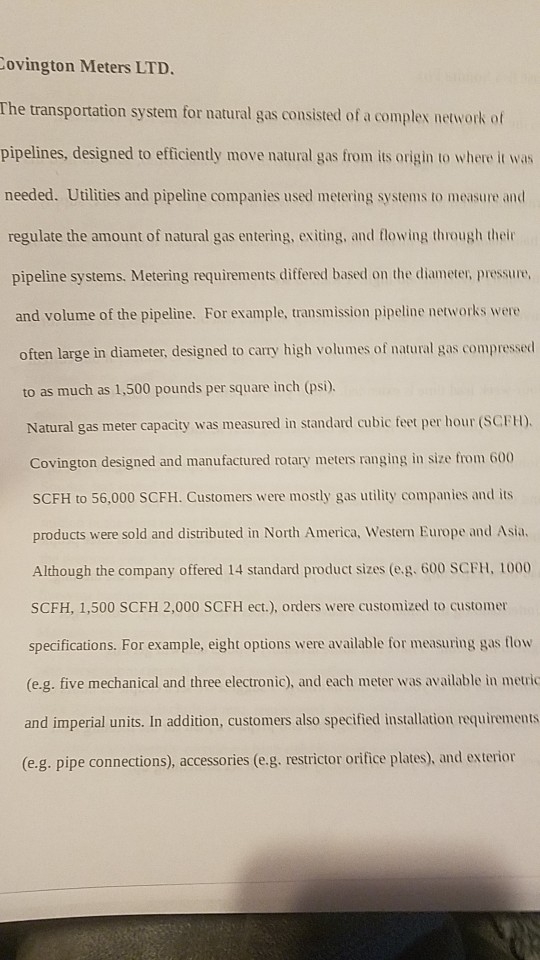
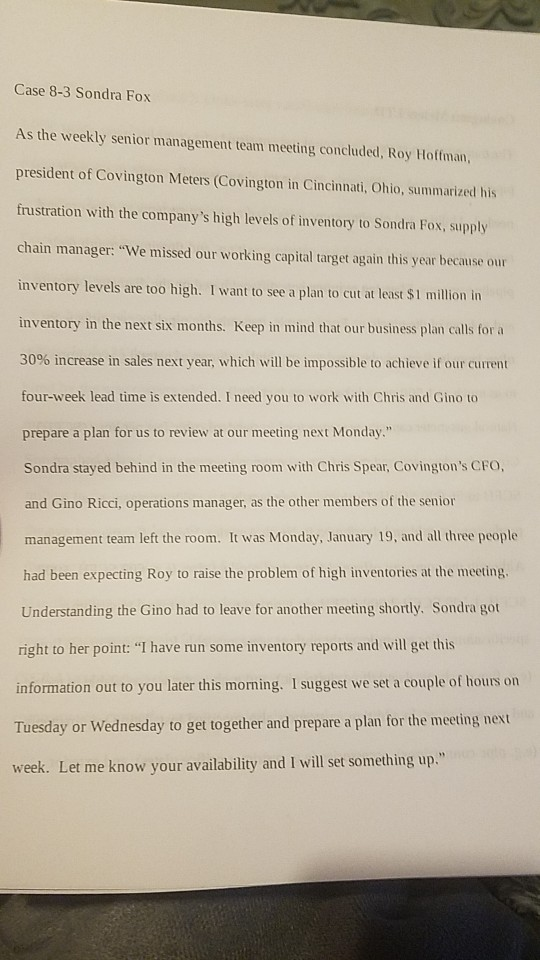
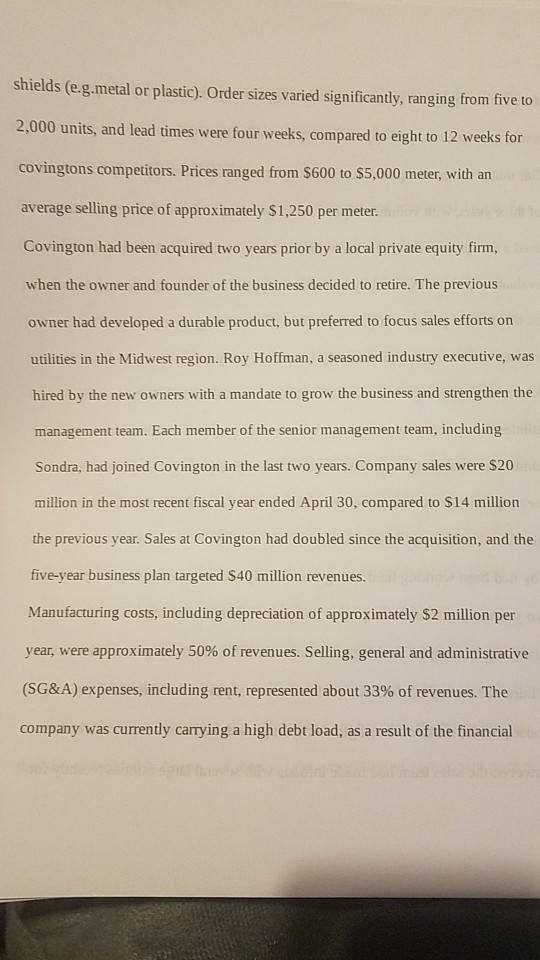
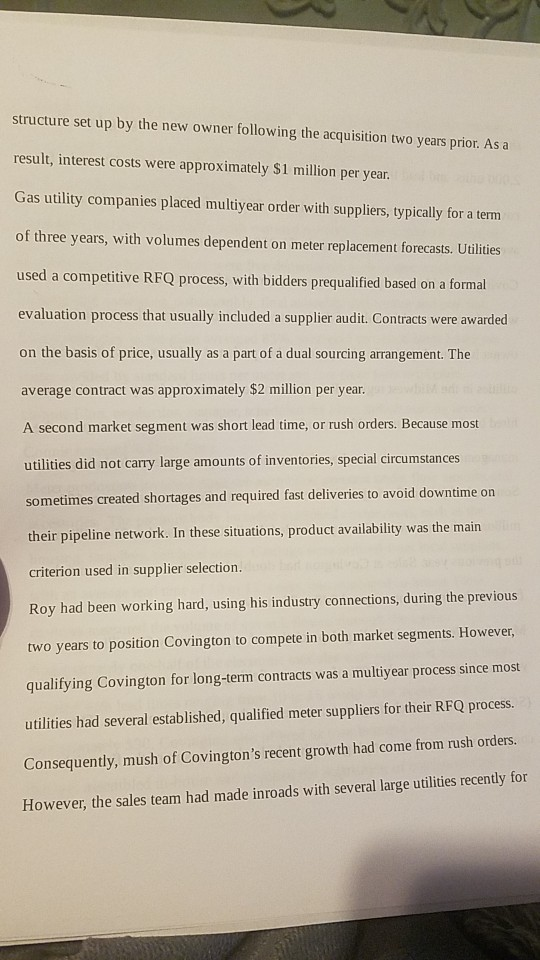
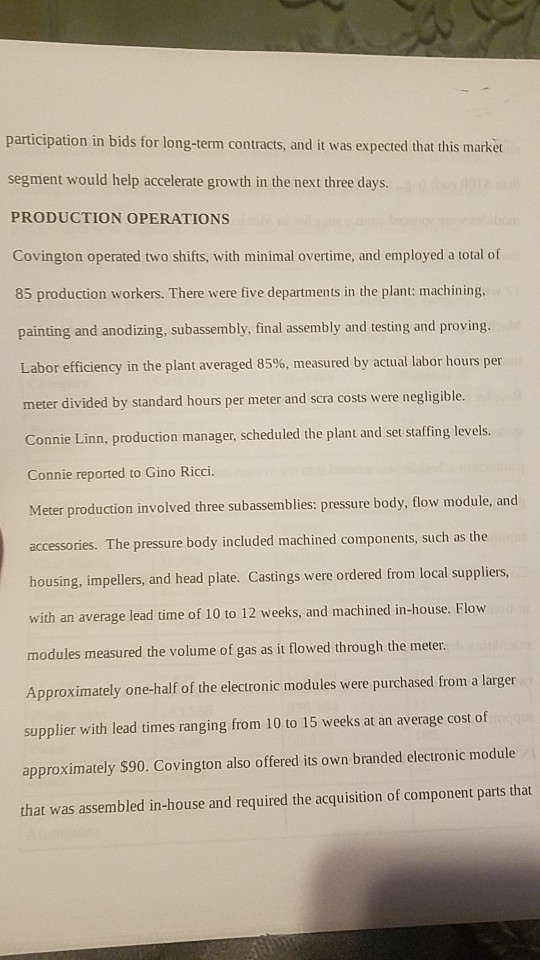
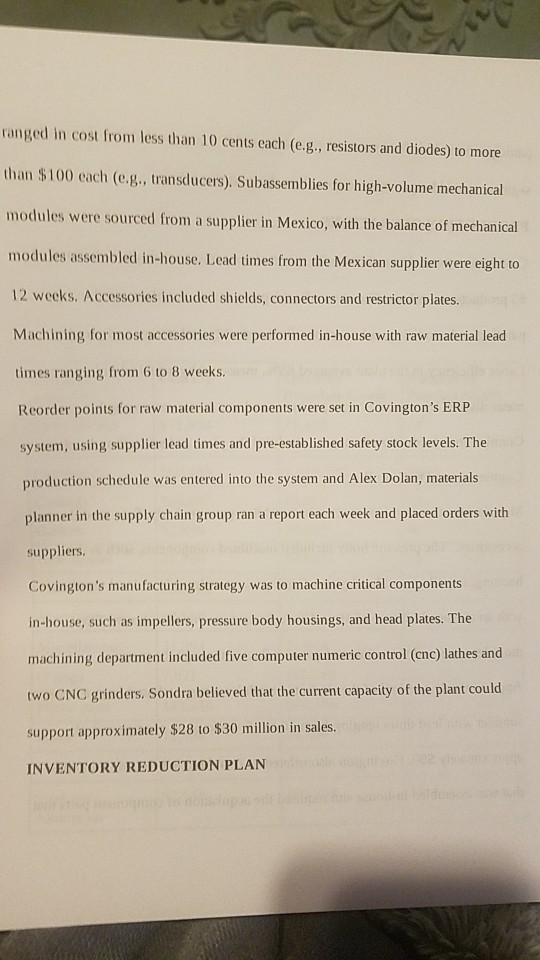
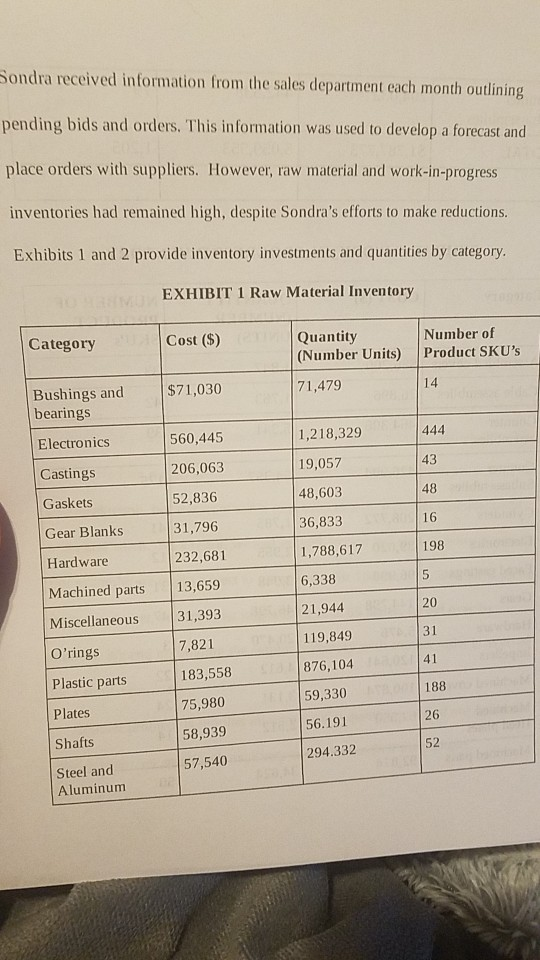
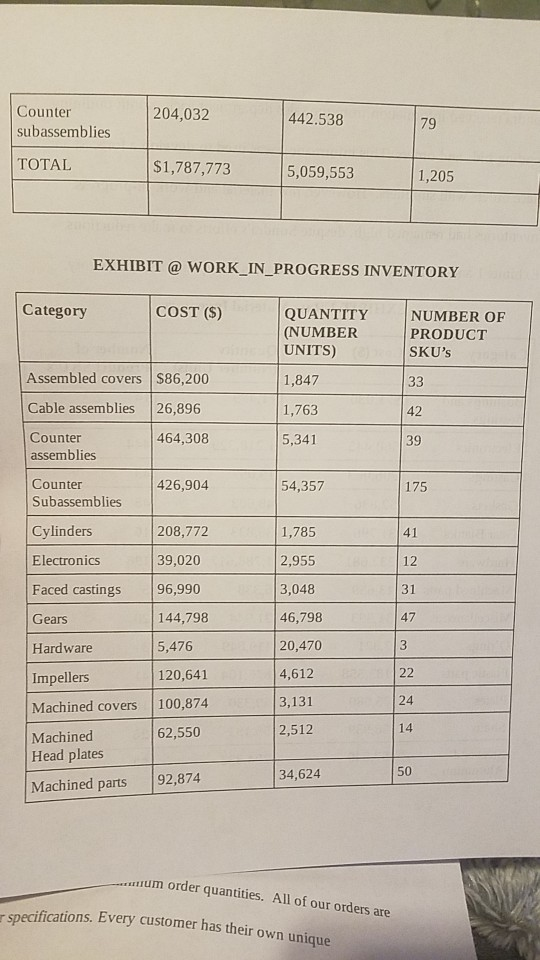
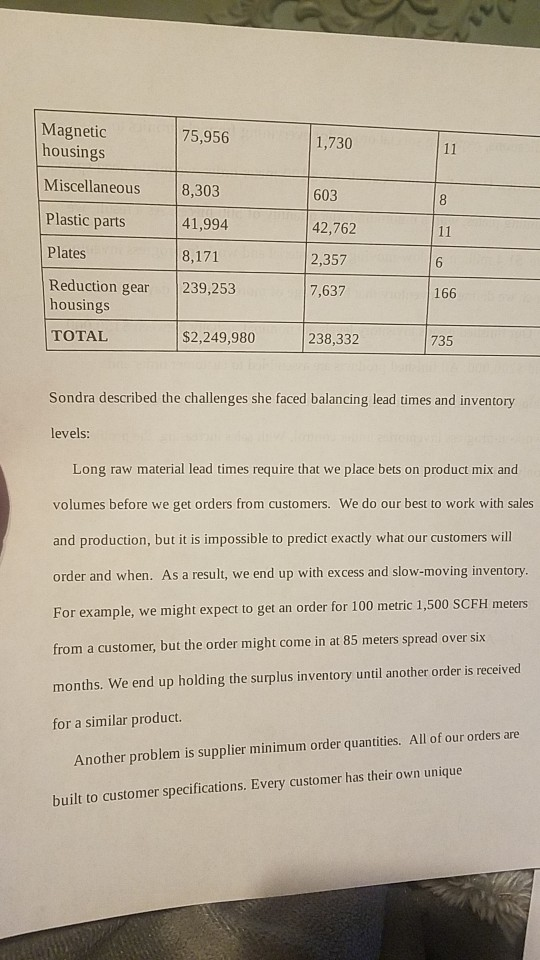
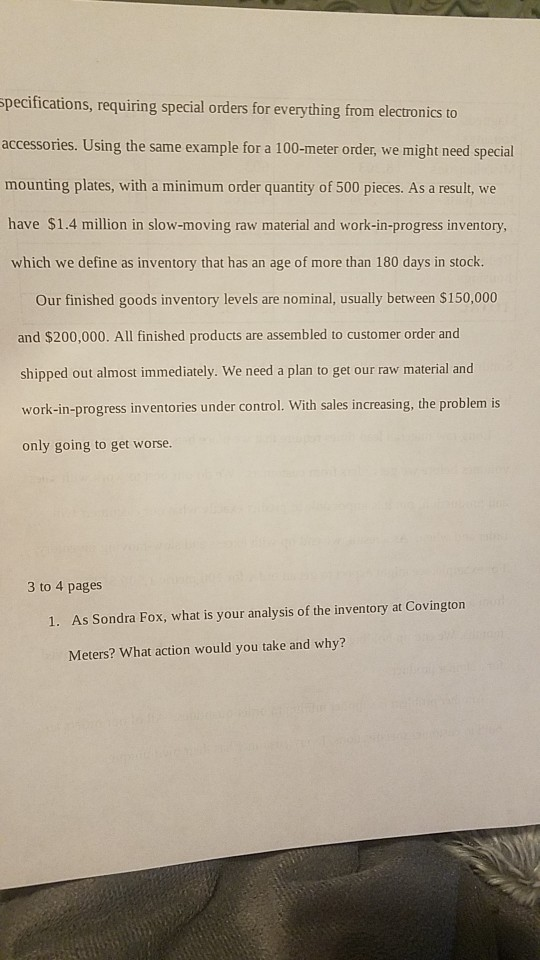
Covington Meters LTD. The transportation system for natural gas consisted of a complex network of pipelines, designed to efficiently move natural gas from its origin to where it was needed. Utilities and pipeline companies used metering systems to measure and regulate the amount of natural gas entering, exiting, and flowing through their pipeline systems, Metering requirements differed based on the diameter pressure and volume of the pipeline. For example, transmission pipeline networks were often large in diameter, designed to carry high volumes of natural gas compressed to as much as 1,500 pounds per square inch (psi). Natural gas meter capacity was measured in standard cubic feet per hour (SCFH). Covington designed and manufactured rotary meters ranging in size from 600 SCFH to 56,000 SCFH. Customers were mostly gas utility companies and its products were sold and distributed in North America, Western Europe and Asia. Although the company offered 14 standard product sizes (eg. 600 SCFH, 1000 SCFH, 1,500 SCFH 2,000 SCFH ect.), orders were customized to customer specifications. For example, eight options were available for measuring gas flow (e.g. five mechanical and three electronic), and each meter was available in metric and imperial units. In addition, customers also specified installation requirements (e.g. pipe connections), accessories (e.g. restrictor orifice plates), and exterior Case 8-3 Sondra Fox As the weekly senior management team meeting concluded, Roy Hoffman, president of Covington Meters (Covington in Cincinnati, Ohio, summarized his frustration with the company's high levels of inventory to Sondra Fox, supply chain manager: "We missed our working capital target again this year because our inventory levels are too high. I want to see a plan to cut at least $1 million in inventory in the next six months. Keep in mind that our business plan calls for a 30% increase in sales next year, which will be impossible to achieve if our current four-week lead time is extended. I need you to work with Chris and Gino to prepare a plan for us to review at our meeting next Monday." Sondra stayed behind in the meeting room with Chris Spear, Covington's CFO, and Gino Ricci, operations manager, as the other members of the senior management team left the room. It was Monday, January 19, and all three people had been expecting Roy to raise the problem of high inventories at the meeting. Understanding the Gino had to leave for another meeting shortly. Sondra got right to her point: "I have run some inventory reports and will get this information out to you later this morning. I suggest we set a couple of hours on Tuesday or Wednesday to get together and prepare a plan for the meeting next week. Let me know your availability and I will set something up." shields (e.g.metal or plastic). Order sizes varied significantly, ranging from five to 2,000 units, and lead times were four weeks, compared to eight to 12 weeks for Covingtons competitors. Prices ranged from $600 to $5,000 meter, with an average selling price of approximately $1,250 per meter. Covington had been acquired two years prior by a local private equity firm, when the owner and founder of the business decided to retire. The previous owner had developed a durable product, but preferred to focus sales efforts on utilities in the Midwest region. Roy Hoffman, a seasoned industry executive, was hired by the new owners with a mandate to grow the business and strengthen the management team. Each member of the senior management team, including Sondra, had joined Covington in the last two years. Company sales were $20 million in the most recent fiscal year ended April 30, compared to $14 million the previous year. Sales at Covington had doubled since the acquisition, and the five-year business plan targeted $40 million revenues. Manufacturing costs, including depreciation of approximately $2 million per year, were approximately 50% of revenues. Selling, general and administrative (SG&A) expenses, including rent, represented about 33% of revenues. The company was currently carrying a high debt load, as a result of the financial structure set up by the new owner following the acquisition two years prior. As a result, interest costs were approximately $1 million per year. Gas utility companies placed multiyear order with suppliers, typically for a term of three years, with volumes dependent on meter replacement forecasts. Utilities used a competitive RFQ process, with bidders prequalified based on a formal evaluation process that usually included a supplier audit. Contracts were awarded on the basis of price, usually as a part of a dual sourcing arrangement. The average contract was approximately $2 million per year. A second market segment was short lead time, or rush orders. Because most utilities did not carry large amounts of inventories, special circumstances sometimes created shortages and required fast deliveries to avoid downtime on their pipeline network. In these situations, product availability was the main criterion used in supplier selection. Roy had been working hard, using his industry connections, during the previous two years to position Covington to compete in both market segments. However, qualifying Covington for long-term contracts was a multiyear process since most utilities had several established, qualified meter suppliers for their RFQ process. Consequently, mush of Covington's recent growth had come from rush orders. However, the sales team had made inroads with several large utilities recently for participation in bids for long-term contracts, and it was expected that this market segment would help accelerate growth in the next three days. PRODUCTION OPERATIONS Covington operated two shifts, with minimal overtime, and employed a total of 85 production workers. There were five departments in the plant: machining, painting and anodizing, subassembly, final assembly and testing and proving. Labor efficiency in the plant averaged 85%, measured by actual labor hours per meter divided by standard hours per meter and scra costs were negligible. Connie Linn, production manager, scheduled the plant and set staffing levels. Connie reported to Gino Ricci. Meter production involved three subassemblies: pressure body, flow module, and accessories. The pressure body included machined components, such as the housing, impellers, and head plate. Castings were ordered from local suppliers, with an average lead time of 10 to 12 weeks, and machined in-house. Flow modules measured the volume of gas as it flowed through the meter. Approximately one-half of the electronic modules were purchased from a larger supplier with lead times ranging from 10 to 15 weeks at an average cost of approximately $90. Covington also offered its own branded electronic module that was assembled in-house and required the acquisition of component parts that ranged in cost from less than 10 cents each (e.g., resistors and diodes) to more than $100 cach (c.g., transducers). Subassemblies for high-volume mechanical modules were sourced from a supplier in Mexico, with the balance of mechanical modules assembled in-house. Lead times from the Mexican supplier were eight to 12 weeks. Accessories included shields, connectors and restrictor plates. Machining for most accessories were performed in-house with raw material lead times ranging from 6 to 8 weeks. Reorder points for raw material components were set in Covington's ERP system, using supplier lead times and pre-established safety stock levels. The production schedule was entered into the system and Alex Dolan, materials planner in the supply chain group ran a report each week and placed orders with suppliers. Covington's manufacturing strategy was to machine critical components in-house, such as impellers, pressure body housings, and head plates. The machining department included five computer numeric control (cnc) lathes and two CNC grinders, Sondra believed that the current capacity of the plant could support approximately $28 to $30 million in sales. INVENTORY REDUCTION PLAN Counter subassemblies 204,032 442.538 79 TOTAL $1,787,773 5,059,553 1,205 EXHIBIT @ WORK_IN_PROGRESS INVENTORY Category COST ($) QUANTITY (NUMBER UNITS) NUMBER OF PRODUCT SKU's Assembled covers $86,200 1,847 33 26,896 1,763 Cable assemblies Counter assemblies 464,308 5,341 426,904 54,357 Counter Subassemblies 175 Cylinders 41 Electronics Faced castings Gears Hardware 208,772 39,020 96,990 144,798 5,476 120,641 100,874 62,550 1,785 2,955 3,048 46,798 20,470 4,612 3,131 31 47 22 Impellers Machined covers 2,512 Machined Head plates 34,624 Machined parts 92,874 um order quantities. All of our orders are specifications. Every customer has their own Magnetic housings 75,956 1,730 Miscellaneous 8,303 Plastic parts 603 42,762 41,994 Plates 8,171 2,357 239,253 7,637 166 Reduction gear housings TOTAL $2,249,980 238,332 735 Sondra described the challenges she faced balancing lead times and inventory levels: Long raw material lead times require that we place bets on product mix and volumes before we get orders from customers. We do our best to work with sales and production, but it is impossible to predict exactly what our customers will order and when. As a result, we end up with excess and slow-moving inventory. For example, we might expect to get an order for 100 metric 1,500 SCFH meters from a customer, but the order might come in at 85 meters spread over six months. We end up holding the surplus inventory until another order is received for a similar product. Another problem is supplier minimum order quantities. All of our orders are built to customer specifications. Every customer has their own unique Specifications, requiring special orders for everything from electronics to accessories. Using the same example for a 100-meter order, we might need special mounting plates, with a minimum order quantity of 500 pieces. As a result, we have $1.4 million in slow-moving raw material and work-in-progress inventory, which we define as inventory that has an age of more than 180 days in stock. Our finished goods inventory levels are nominal, usually between $150,000 and $200,000. All finished products are assembled to customer order and shipped out almost immediately. We need a plan to get our raw material and work-in-progress inventories under control. With sales increasing, the problem is only going to get worse. 3 to 4 pages 1. As Sondra Fox, what is your analysis of the inventory at Covington Meters? What action would you take and why? Covington Meters LTD. The transportation system for natural gas consisted of a complex network of pipelines, designed to efficiently move natural gas from its origin to where it was needed. Utilities and pipeline companies used metering systems to measure and regulate the amount of natural gas entering, exiting, and flowing through their pipeline systems, Metering requirements differed based on the diameter pressure and volume of the pipeline. For example, transmission pipeline networks were often large in diameter, designed to carry high volumes of natural gas compressed to as much as 1,500 pounds per square inch (psi). Natural gas meter capacity was measured in standard cubic feet per hour (SCFH). Covington designed and manufactured rotary meters ranging in size from 600 SCFH to 56,000 SCFH. Customers were mostly gas utility companies and its products were sold and distributed in North America, Western Europe and Asia. Although the company offered 14 standard product sizes (eg. 600 SCFH, 1000 SCFH, 1,500 SCFH 2,000 SCFH ect.), orders were customized to customer specifications. For example, eight options were available for measuring gas flow (e.g. five mechanical and three electronic), and each meter was available in metric and imperial units. In addition, customers also specified installation requirements (e.g. pipe connections), accessories (e.g. restrictor orifice plates), and exterior Case 8-3 Sondra Fox As the weekly senior management team meeting concluded, Roy Hoffman, president of Covington Meters (Covington in Cincinnati, Ohio, summarized his frustration with the company's high levels of inventory to Sondra Fox, supply chain manager: "We missed our working capital target again this year because our inventory levels are too high. I want to see a plan to cut at least $1 million in inventory in the next six months. Keep in mind that our business plan calls for a 30% increase in sales next year, which will be impossible to achieve if our current four-week lead time is extended. I need you to work with Chris and Gino to prepare a plan for us to review at our meeting next Monday." Sondra stayed behind in the meeting room with Chris Spear, Covington's CFO, and Gino Ricci, operations manager, as the other members of the senior management team left the room. It was Monday, January 19, and all three people had been expecting Roy to raise the problem of high inventories at the meeting. Understanding the Gino had to leave for another meeting shortly. Sondra got right to her point: "I have run some inventory reports and will get this information out to you later this morning. I suggest we set a couple of hours on Tuesday or Wednesday to get together and prepare a plan for the meeting next week. Let me know your availability and I will set something up." shields (e.g.metal or plastic). Order sizes varied significantly, ranging from five to 2,000 units, and lead times were four weeks, compared to eight to 12 weeks for Covingtons competitors. Prices ranged from $600 to $5,000 meter, with an average selling price of approximately $1,250 per meter. Covington had been acquired two years prior by a local private equity firm, when the owner and founder of the business decided to retire. The previous owner had developed a durable product, but preferred to focus sales efforts on utilities in the Midwest region. Roy Hoffman, a seasoned industry executive, was hired by the new owners with a mandate to grow the business and strengthen the management team. Each member of the senior management team, including Sondra, had joined Covington in the last two years. Company sales were $20 million in the most recent fiscal year ended April 30, compared to $14 million the previous year. Sales at Covington had doubled since the acquisition, and the five-year business plan targeted $40 million revenues. Manufacturing costs, including depreciation of approximately $2 million per year, were approximately 50% of revenues. Selling, general and administrative (SG&A) expenses, including rent, represented about 33% of revenues. The company was currently carrying a high debt load, as a result of the financial structure set up by the new owner following the acquisition two years prior. As a result, interest costs were approximately $1 million per year. Gas utility companies placed multiyear order with suppliers, typically for a term of three years, with volumes dependent on meter replacement forecasts. Utilities used a competitive RFQ process, with bidders prequalified based on a formal evaluation process that usually included a supplier audit. Contracts were awarded on the basis of price, usually as a part of a dual sourcing arrangement. The average contract was approximately $2 million per year. A second market segment was short lead time, or rush orders. Because most utilities did not carry large amounts of inventories, special circumstances sometimes created shortages and required fast deliveries to avoid downtime on their pipeline network. In these situations, product availability was the main criterion used in supplier selection. Roy had been working hard, using his industry connections, during the previous two years to position Covington to compete in both market segments. However, qualifying Covington for long-term contracts was a multiyear process since most utilities had several established, qualified meter suppliers for their RFQ process. Consequently, mush of Covington's recent growth had come from rush orders. However, the sales team had made inroads with several large utilities recently for participation in bids for long-term contracts, and it was expected that this market segment would help accelerate growth in the next three days. PRODUCTION OPERATIONS Covington operated two shifts, with minimal overtime, and employed a total of 85 production workers. There were five departments in the plant: machining, painting and anodizing, subassembly, final assembly and testing and proving. Labor efficiency in the plant averaged 85%, measured by actual labor hours per meter divided by standard hours per meter and scra costs were negligible. Connie Linn, production manager, scheduled the plant and set staffing levels. Connie reported to Gino Ricci. Meter production involved three subassemblies: pressure body, flow module, and accessories. The pressure body included machined components, such as the housing, impellers, and head plate. Castings were ordered from local suppliers, with an average lead time of 10 to 12 weeks, and machined in-house. Flow modules measured the volume of gas as it flowed through the meter. Approximately one-half of the electronic modules were purchased from a larger supplier with lead times ranging from 10 to 15 weeks at an average cost of approximately $90. Covington also offered its own branded electronic module that was assembled in-house and required the acquisition of component parts that ranged in cost from less than 10 cents each (e.g., resistors and diodes) to more than $100 cach (c.g., transducers). Subassemblies for high-volume mechanical modules were sourced from a supplier in Mexico, with the balance of mechanical modules assembled in-house. Lead times from the Mexican supplier were eight to 12 weeks. Accessories included shields, connectors and restrictor plates. Machining for most accessories were performed in-house with raw material lead times ranging from 6 to 8 weeks. Reorder points for raw material components were set in Covington's ERP system, using supplier lead times and pre-established safety stock levels. The production schedule was entered into the system and Alex Dolan, materials planner in the supply chain group ran a report each week and placed orders with suppliers. Covington's manufacturing strategy was to machine critical components in-house, such as impellers, pressure body housings, and head plates. The machining department included five computer numeric control (cnc) lathes and two CNC grinders, Sondra believed that the current capacity of the plant could support approximately $28 to $30 million in sales. INVENTORY REDUCTION PLAN Counter subassemblies 204,032 442.538 79 TOTAL $1,787,773 5,059,553 1,205 EXHIBIT @ WORK_IN_PROGRESS INVENTORY Category COST ($) QUANTITY (NUMBER UNITS) NUMBER OF PRODUCT SKU's Assembled covers $86,200 1,847 33 26,896 1,763 Cable assemblies Counter assemblies 464,308 5,341 426,904 54,357 Counter Subassemblies 175 Cylinders 41 Electronics Faced castings Gears Hardware 208,772 39,020 96,990 144,798 5,476 120,641 100,874 62,550 1,785 2,955 3,048 46,798 20,470 4,612 3,131 31 47 22 Impellers Machined covers 2,512 Machined Head plates 34,624 Machined parts 92,874 um order quantities. All of our orders are specifications. Every customer has their own Magnetic housings 75,956 1,730 Miscellaneous 8,303 Plastic parts 603 42,762 41,994 Plates 8,171 2,357 239,253 7,637 166 Reduction gear housings TOTAL $2,249,980 238,332 735 Sondra described the challenges she faced balancing lead times and inventory levels: Long raw material lead times require that we place bets on product mix and volumes before we get orders from customers. We do our best to work with sales and production, but it is impossible to predict exactly what our customers will order and when. As a result, we end up with excess and slow-moving inventory. For example, we might expect to get an order for 100 metric 1,500 SCFH meters from a customer, but the order might come in at 85 meters spread over six months. We end up holding the surplus inventory until another order is received for a similar product. Another problem is supplier minimum order quantities. All of our orders are built to customer specifications. Every customer has their own unique Specifications, requiring special orders for everything from electronics to accessories. Using the same example for a 100-meter order, we might need special mounting plates, with a minimum order quantity of 500 pieces. As a result, we have $1.4 million in slow-moving raw material and work-in-progress inventory, which we define as inventory that has an age of more than 180 days in stock. Our finished goods inventory levels are nominal, usually between $150,000 and $200,000. All finished products are assembled to customer order and shipped out almost immediately. We need a plan to get our raw material and work-in-progress inventories under control. With sales increasing, the problem is only going to get worse. 3 to 4 pages 1. As Sondra Fox, what is your analysis of the inventory at Covington Meters? What action would you take and why
Step by Step Solution
There are 3 Steps involved in it
Step: 1

Get Instant Access to Expert-Tailored Solutions
See step-by-step solutions with expert insights and AI powered tools for academic success
Step: 2

Step: 3

Ace Your Homework with AI
Get the answers you need in no time with our AI-driven, step-by-step assistance
Get Started


